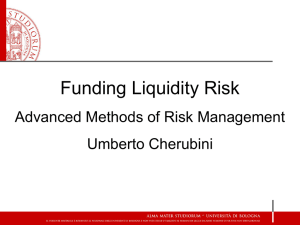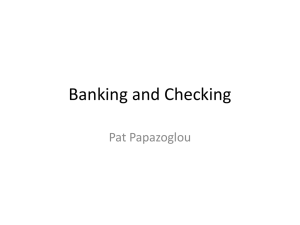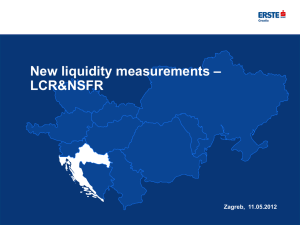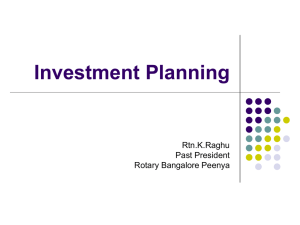Bank of Italy 21 March 2011
advertisement
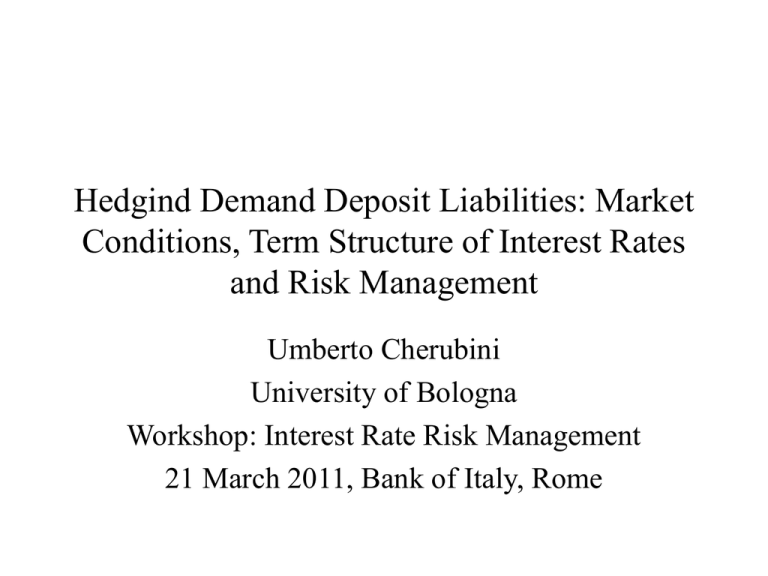
Hedgind Demand Deposit Liabilities: Market Conditions, Term Structure of Interest Rates and Risk Management Umberto Cherubini University of Bologna Workshop: Interest Rate Risk Management 21 March 2011, Bank of Italy, Rome Outline • Interest rate risk: from ALM to risk mgmt – Classical non-stochastic immunization theory – Interest rate risk management – Immunization with stochatic interest rates • Quantity risk: modelling deposit demand – Structural models (?) vs reduced form – Dependence between demand deposit and interest rates: a copula approach proposal • Stress-testing and VaR measures The credit crisis and liquidity risk • If you do not trust your neighbour and do not trust your assets, you are in liquidity trouble • Funding liquidity risk: you must come up with funding for your assets, but the market is dry. Solutions: i) chase retail investors ii) rely on quantitative easing (won’t last long) • Market liquidity risk: you are forced to unwind positions in periods of market stress, and you may not be able to find counterparts for the deal, unless at deep discount. Solution: quantitative easing (place illiquid bonds as collateral) Classical immunization: flows • Maturity gap: banks lending on different (longer) repricing periods than liabilities are exposed to reduction of the spread earned when interest rate rises. • Cash flow immunization would call for maturity matching. Assets should be have the same repricing period of liability, or, deposits should be hedged by being rolled over at the short term rate. Classical immunization: value • Fisher – Weil: close the duration gap – Immunization against parallel shifts – Zero-coupon liability • Reddington: keep an eye on convexity – Immunization against parallel shifts – Convexity of liabilities lower than that of assets • Fong – Vasicek: the kind of shif matters – Immunization against whatever shift – Lower bound to losses positive or negative given convexity of the shift IRRM = ALM risk management • Asset-Liability-Management is about sensitivity of balance sheet income and value to changes in the economic scenario (ALM requires scenarios) • Value-at-Risk is a matter of (i) time and (ii) chance. It may be traced back to the system of margins in derivatives markets. • Stress-testing is a matter of information. We evaluate the effect of a set of scenarios on a portfolio and the amount of capital. • Notice: ALM and risk management have in common scenarios. Integration of the two (that we call interest rate risk management requires to work on this intersection) Hedging by swaps • Classical immunisation was non-stochastic and it was not based on a model of the banking system. • Jarrow and Van Deventer (1998) devised a model with stochastic interest rates, market segmentation and limited competition among banks, so that the interest rate spread between the risk free rate and the rate of deposits was allowed to be positive. • In this case the present value of the spread adds to the value of deposits, and may be read as the net present value of a swap contract. In this case hedging would require shorting this swap, and perfect mathching would not work. Extensions • Return from maturity transformation. Assume deposits are invested in long term (risk free) assets. Then, the value of deposit would turn into a CMS and would exploit a convexity adjustment bonus. • Swaptions. One could conceive contingent hedging, triggered by market conditions, in which case one should resort to receiver swaptions (put options on swaps) Basis risk • In the standard model, it is often assumed that deposits are perfectly correlated with the risk free rate, so that the hedging resolves in a replication of a swap contract by positions in the risk-free bond market. • Basis risk. An extension that seems mandatory in face of the recent banking crisis is to allow for other elements determining the wedge between risk free rates and rates on deposits. Following the same line of Jarrow and Van Deventer model one should include other market variables, first of all an indicator of the credit worthiness of the banking system as a whole. • A possible financial engineering could be buying insurance against the increase in CDS spread in the banking system, or making the swap contract “hybrid”. Quantity risk • What makes demand deposit hedging quite peculiar is quantity risk. Since deposits can be withdrawn with no notice, returns on assets and liabilities may fluctuate not only because of changes in market rates, but also changes in the amount of deposits on which this spread is computed. For this reason the swap contract in the JarrowVan Deventer approach has a stochastic amortizing structure. • The problem is to model: i) the distribution of demand deposit in each period of time; ii) the dependence structure between the amount of deposits and interest rates. • In a sense, it is the old problem of liquidity trading vs informed trading. Modelling deposit demand • Structural models: these models should be based on the micro-economic structure of demand deposits at the individual level, followed by aggregation at the industry level • Reduced form models: these models should be based on statistical regularities observed on the distribution and the dynamics of the aggregate demand deposits. • Notice. This distinction is new, but is motivated by the similarity between quantity risk and credit risk Structural models Example from the literature • A structural model coming from the academia is Nystrom (2008). • Each individual demands transaction balances and demand deposits as a function of: – i) income dynamics – ii) a target deposits/income ratio • The key point is that the target ratio is a function of the difference between the deposit rate and a reservation (strike) price. • Aggregation is obtained by averaging income dynamics and dispersion around average behavior is modelled by selecting a distribution function of the strikes. Structural models Example from the industry • A major Italian bank is pursuing a policy of buying and selling its bonds at the same credit spread as the placement day. This way, the bonds issued by the bank are substitute of deposits from the point of view of customers. • In the evaluation of this policy, the bank relies on a behavioral model according to which: – the customer decision to sell and buy the bond is triggered by the difference between the current spreads prevailing on the banking system and the original spread (a real option model, like that of Nystrom) – customers are assumed to be sluggish to move in and out, because of irrational exercize behavior or monitoring costs. This is modelled by multiplying the spread difference times a participation rate lower than one. Reduced form models • Specification of deposits demand is based on statistical/econometric analysis. • Typical specification: – Linear/log-linear relationship with the interest rate dynamics – Autoregressive dynamics • What is missing: would be interesting to include a liquidity crisis scenario using the same technology applied by Cetin, Jarrow Protter (2004) to market liquidity risk. A copula based proposal • A natural idea stemming from the similarity between the demand deposit problem and large credit portfolio models is to resort to copulas. • Copula functions could provide: – Flexible specification of the marginal distributions of deposits and interest rates – Flexible representation of the dependence structure between deposits demand and interest rates – Flexible representation of deposits dynamics A copula-based structural model • Assume a homogeneous model in which all agents have the same deposit income ratio and same correlation with an unobserved common factor. • Possible specifications are Vasicek model (gaussian dependence) or Schonbucher (Archimedean dependence) • These specifications would yield the probability law of the deposit income ratio that could be used as the marginal distribution for deposits. • The dynamics would be finally recovered by applying the dynamics of income to the ratio. • Notice: this is conjecture. Everything should be proved in a model built on micro-foundations, and probably different specifications would come out 16 Vasicek density function 14 12 10 R h o = 0 .2 8 R h o = 0 .6 R h o = 0 .8 6 4 2 0 0 0 ,1 0 ,2 0 ,3 0 ,4 0 ,5 0 ,6 0 ,7 0 ,8 0 ,9 1 A copula based algorithm • Estimate the dependence structure between deposit volumes and interest rates (moment matching, IFM, canonical ML) and select the best fit copula: – Notice. The conditional distribution of deposit volumes is the partial derivative of the copula function. • Specify the marginal distribution of deposit volumes (the structural model above or a non parametric representation). • Specify the marginal distribution of interest rates: the distribution may be defined on the basis of historical data and/or scenarios (we suggest a bayesian approach). A bayesian specification of the interest rate law • Cherubini and Della Lunga (1999) (but see also Kupiec, 1998), propose a bayesian model for risk evaluation, based on: i) historical info; ii) scenarios • They use Black-Litterman approach from asset management to yield the posterior distribution of profits and losses of a levered portfolio conditional on a set of scenarios • It turns out that stress-testing and VaR are the extreme outcomes of the same from the same procedure: stresstesting is obtained when perfect confidence is assigned to the precision of the scenario and VaR is obtained when no confidence is given. Scenario based risk management is in the middle. An example of scenario • Assume a model in which interest rates are the only state variable (and determine deposit volumes). Suppose you have historical information on the 1, 10 and 30 year maturity of the Italian yield curve, summarized in the statistics é5.04ù é0.24ù m º ê5.39ú s º ê 0.11ú ê ú ê ú êë 6.21úû êë 0.11úû 0.86 0.81ù é 1 R º ê0.86 1 0.97 ú ê ú 1 úû êë 0.81 0.97 • A possible scenario is described by the statement: – “The 1 year rate will rise to 6% (± 10 bp s.e.)” The Black & Litterman approach • In mathematical terms: e1' r = q + 1 = 6% + 1 , 1 ~ N(0,0.001) • …and from the joint distribution V e1 ér ù é m ù é V ù ,ê ú ê ú ~ N ê ú ë q û ë e 1 ' m û ë e 1 ' V ' e 1 ' Ve 1 û • where V is the covariance matrix... The conditional scenario …we may compute the conditional scenario ( r q ~ N m Ve1 s 12 12 ) -1 (6% - e1 ' m ) ( ; V - Ve1 s 12 ) 2 -1 1 e1 ' V and new (posterior) statistics... é6.00ù é 0.01ù m º ê5.77 ú s º ê0.06ú ê ú ê ú êë6.58úû êë0.07 úû 0.04 0.03ù é 1 R º ê0.04 1 0.92ú ê ú 1 úû êë0.03 0.92 The effects on the yield curve... Figure 1 7 6.5 Yields 6 Historic Scenario 5.5 5 4.5 1 6 11 16 Maturities 21 26 …and on the value of positions Table 1. Stress testing report Scenario: the short term rate increases to 6% (0.1 s.d.) Maturity Nominal Cur. MtM Scen.MtM Mean Loss Scen. VaR 1 Year 100 95.08 94.18 0.90 0.92 10 Years 100 58.35 56.16 2.17 2.93 30 Years 100 15.54 13.88 1.66 2.30 MtM = Marking-to-Market Value Mean Loss = Expected values of the difference between current and future MtM values Scen. VaR = 1% percentile of the difference between current and future MtM values References (some…) • • • • • • • • Cetin U. – R.A. Jarrow – P. Protter (2004): “Liquidity Risk and Arbitrage Pricing Theory”, Finance and Stochastics, 8, 311-341. Cherubini U. – G. Della Lunga (1999): “Stress-Testing Techniques and VaR Measures: A Unified Approach”, Rivista di Matematica per le Scienze Economiche e Sociali, 22, 7799. Dewachter H – M. Lyrio – K. Maes (2008): “A Multifactor Model for the Evaluation and Risk Management of Demand Deposits”, working paper n. 83, National Bank of Belgium Jarrow R.A. – D.R. Van Deventer (1998): “The Arbitrage-Free Valuation and Hedging of Demand Deposits and Credit Card Loans”, Journal of Banking and Finance, 22, 249272 Kalbrener M. – J. Willing (2004): “Risk Management of Non-Maturing Securities”, Journal of Banking and Finance, 28, 1547-1568 Kupiec P.H. (1998): “Stress-Testing in a Value-at-Risk Framework”, The Journal of Derivatives, 6, 7-24. Nystrom K. (2008): “On Deposit Volumes and the Valuation of Non-Maturing Liabilities”, Journal of Economic Dynamics and Control, 32, 709-756 Nawalka S.K. – G.M. Soto (2009): “Managing Interest Rate Risk: The Next Challenge?”, working paper, www.ssrn.com/abstract=1392543
